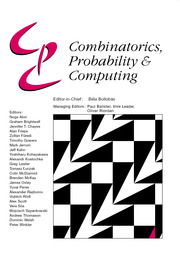Article contents
Linear Index Coding via Semidefinite Programming†
Published online by Cambridge University Press: 29 November 2013
Abstract
In the index coding problem, introduced by Birk and Kol (INFOCOM, 1998), the goal is to broadcast an n-bit word to n receivers (one bit per receiver), where the receivers have side information represented by a graph G. The objective is to minimize the length of a codeword sent to all receivers which allows each receiver to learn its bit. For linear index coding, the minimum possible length is known to be equal to a graph parameter called minrank (Bar-Yossef, Birk, Jayram and Kol, IEEE Trans. Inform. Theory, 2011).
We show a polynomial-time algorithm that, given an n-vertex graph G with minrank k, finds a linear index code for G of length Õ(nf(k)), where f(k) depends only on k. For example, for k = 3 we obtain f(3) ≈ 0.2574. Our algorithm employs a semidefinite program (SDP) introduced by Karger, Motwani and Sudan for graph colouring (J. Assoc. Comput. Mach., 1998) and its refined analysis due to Arora, Chlamtac and Charikar (STOC, 2006). Since the SDP we use is not a relaxation of the minimization problem we consider, a crucial component of our analysis is an upper bound on the objective value of the SDP in terms of the minrank.
At the heart of our analysis lies a combinatorial result which may be of independent interest. Namely, we show an exact expression for the maximum possible value of the Lovász ϑ-function of a graph with minrank k. This yields a tight gap between two classical upper bounds on the Shannon capacity of a graph.
Keywords
Information
- Type
- Paper
- Information
- Copyright
- Copyright © Cambridge University Press 2013
Footnotes
A preliminary version appeared in Proceedings of the 23rd Annual ACM–SIAM Symposium on Discrete Algorithms, 2012, pp. 406–419.
References
- 6
- Cited by

